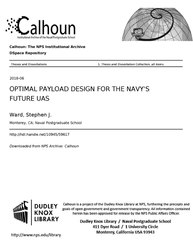File:OPTIMAL PAYLOAD DESIGN FOR THE NAVY'S FUTURE UAS (IA optimalpayloadde1094559617).pdf

Original file (1,275 × 1,650 pixels, file size: 4.93 MB, MIME type: application/pdf, 88 pages)
Captions
Captions
Summary[edit]
| OPTIMAL PAYLOAD DESIGN FOR THE NAVY'S FUTURE UAS
( |
||
|---|---|---|
| Author |
Ward, Stephen J. |
|
| Title |
OPTIMAL PAYLOAD DESIGN FOR THE NAVY'S FUTURE UAS |
|
| Publisher |
Monterey, CA; Naval Postgraduate School |
|
| Description |
The Tern is a future Navy unmanned aerial system that will deploy on and launch from surface ships such as destroyers. It is designed to be capable of performing multiple types of sorties such as anti-submarine warfare; information, surveillance, and reconnaissance; and acting as a node in a communication network. Each type of sortie has different operational and physical requirements manifested in the payload onboard the Tern. There are two forms a payload can take: fixed and modular. The fixed payload is hard-wired into the Tern while the modular payload space on the Tern supports the ability to change the payloads for each sortie. Multiple possible scenarios and operational postures add another level of complexity in determining optimal payload configurations. The overarching issue that we will address in this research is the general design of the Tern payload. This design must take into account the inherent stochasticity of the situations in which the Tern will operate. While conducting a primary task within a sortie, the Tern could also be called to carry out other tasks as the situation dictates. For every possible realization of a sortie a Tern is sent on, there is an optimal payload design that addresses the possible tasks in the sortie. Consequently, each design satisfies a given measure of effectiveness with a certain expected effectiveness. The objective is to find a global payload design that maximizes responsiveness over all possible sorties and scenarios. Subjects: UAS; integer linear program; bin-packing; knapsack; optimization |
|
| Language | English | |
| Publication date | June 2018 | |
| Current location |
IA Collections: navalpostgraduateschoollibrary; fedlink |
|
| Accession number |
optimalpayloadde1094559617 |
|
| Source | ||
| Permission (Reusing this file) |
This publication is a work of the U.S. Government as defined in Title 17, United States Code, Section 101. Copyright protection is not available for this work in the United States. | |
Licensing[edit]
| Public domainPublic domainfalsefalse |
This work is in the public domain in the United States because it is a work prepared by an officer or employee of the United States Government as part of that person’s official duties under the terms of Title 17, Chapter 1, Section 105 of the US Code.
Note: This only applies to original works of the Federal Government and not to the work of any individual U.S. state, territory, commonwealth, county, municipality, or any other subdivision. This template also does not apply to postage stamp designs published by the United States Postal Service since 1978. (See § 313.6(C)(1) of Compendium of U.S. Copyright Office Practices). It also does not apply to certain US coins; see The US Mint Terms of Use.
|
 | |
| This file has been identified as being free of known restrictions under copyright law, including all related and neighboring rights. | ||
https://creativecommons.org/publicdomain/mark/1.0/PDMCreative Commons Public Domain Mark 1.0falsefalse
File history
Click on a date/time to view the file as it appeared at that time.
| Date/Time | Thumbnail | Dimensions | User | Comment | |
|---|---|---|---|---|---|
| current | 14:32, 23 July 2020 |  | 1,275 × 1,650, 88 pages (4.93 MB) | Fæ (talk | contribs) | FEDLINK - United States Federal Collection optimalpayloadde1094559617 (User talk:Fæ/IA books#Fork8) (batch 1993-2020 #24036) |
You cannot overwrite this file.
File usage on Commons
The following page uses this file:
Metadata
This file contains additional information such as Exif metadata which may have been added by the digital camera, scanner, or software program used to create or digitize it. If the file has been modified from its original state, some details such as the timestamp may not fully reflect those of the original file. The timestamp is only as accurate as the clock in the camera, and it may be completely wrong.
| Short title | OPTIMAL PAYLOAD DESIGN FOR THE NAVY'S FUTURE UAS |
|---|---|
| Author | Ward, Stephen J. |
| Software used | Ward, Stephen J. |
| Conversion program | MiKTeX pdfTeX-1.40.18 |
| Encrypted | no |
| Page size | 612 x 792 pts (letter) |
| Version of PDF format | 1.4 |

